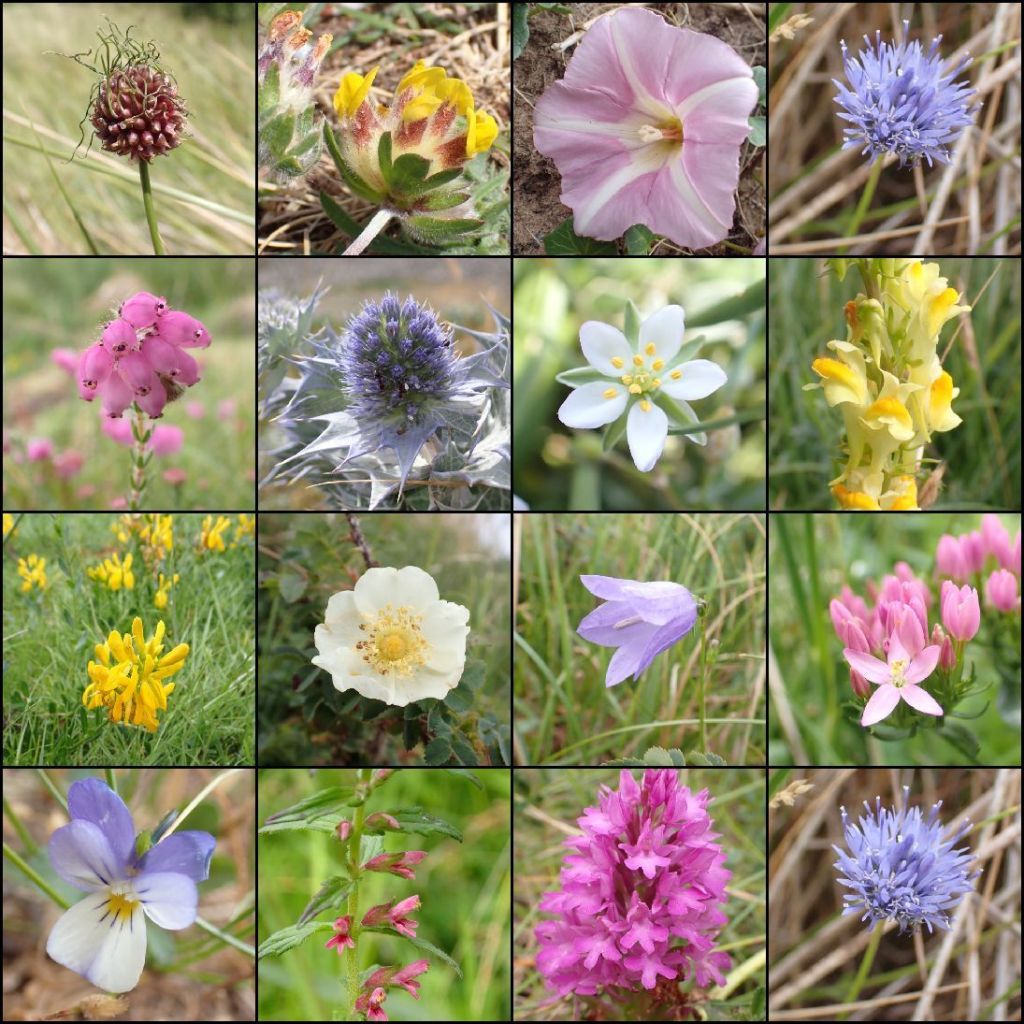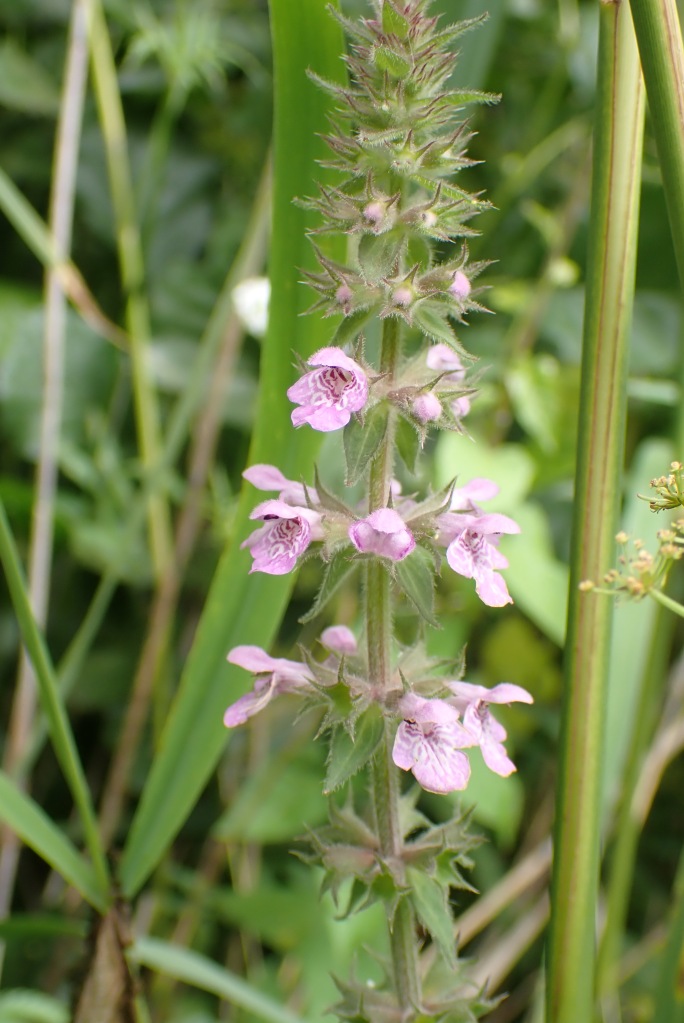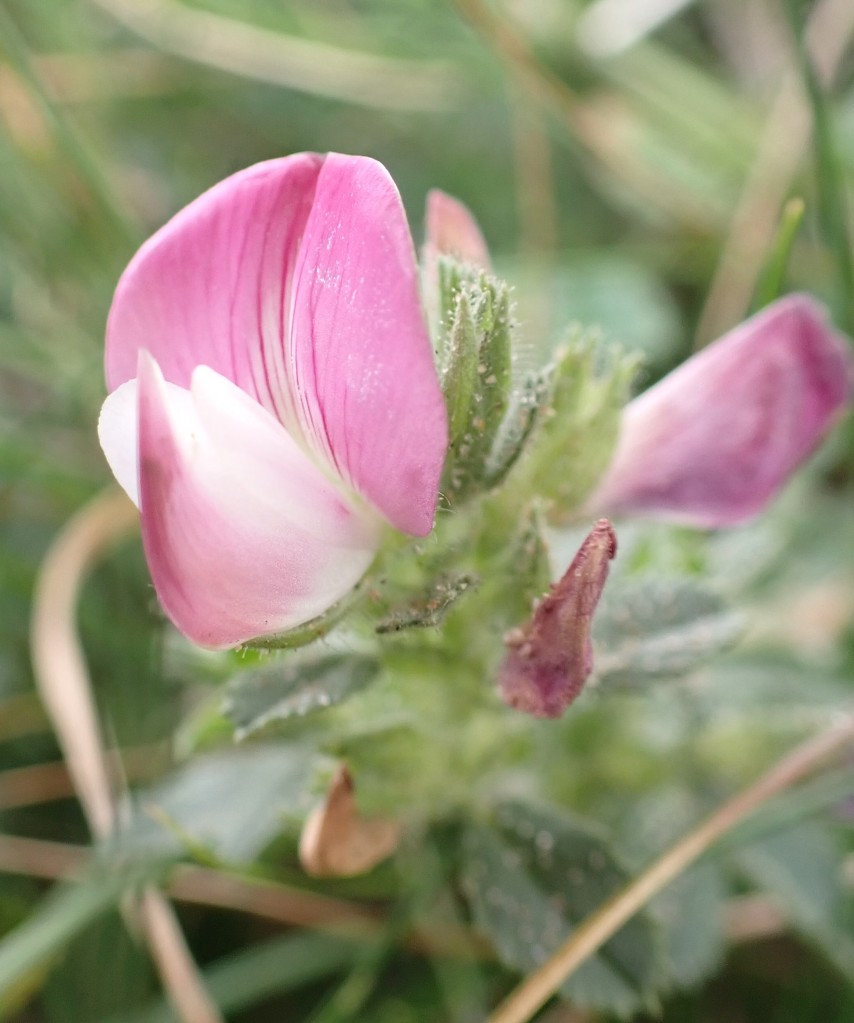I had the privilege of nearly a week in early July doing some solitary walking and mooching around nature reserves in the southern part of the Lake District and the places I enjoyed most included the sand dunes of North Walney Island and Sandscale Haws, both delightful reserves just on the edge of industrial Barrow-in-Furness. There are lots of botanical treats to be found in dunes and in the damper dune slacks behind them – Adder’s Tongue ferns, Restharrow, Sand leeks, semi-parasitic Yellow and Red Bartsia, tiny Wild Pansies, Pyramidal orchids, Strawberry Clover and lots of beautiful Sea Holly.

The environment of sand dunes is obviously a harsh one at times; sand doesn’t retain much water because of its large grain size so, when rain falls, it drains away quickly. Salt spray is an equally big problem; salt on the leaves of plants or in the thin soil draws water out of the plant by osmosis, drying them out even further. Many of the plants which grow really close to the sea in places like salt marshes are halophytes, which have specialised ways of dealing with the problem of salt – sequestering it harmlessly in cell walls or expelling it onto the surface of their leaves. Think about the where the salty taste of samphire comes from!

However something different caught my eye about the plants growing a little further back from the sea on Walney Island – several have leaves and/or flowers with a dense covering of hairs, some of them glandular and sticky to the touch. Leaf hairs or trichomes are one way in which plants protect themselves from too much water loss – when water evaporates from the stomatal pores on the leaf surface, some remains trapped near the leaf by the hairs and this means there is less of a gradient from inside the leaf to outside, driving further evaporation.
But what about glandular hairs? Restharrow and Marsh Woundwort, Yellow Bartsia and Cross-leaved Heath all had a thick covering of glandular hairs on their leaves, flowers or both. How do these help the plants cope with their hostile environment? Glandular hairs on plants perform many different roles, all involving secretion of some substance from the plant; oils or gum-like resins, the acids which fill stinging hairs on nettles or the sticky liquid which both attracts and traps insects on the leaf of a carnivorous sundew plant. But what are they doing on these sand dune plants?
Like plants everywhere, these species need to protect themselves from herbivores and pathogens. We may think that Mint, Sage and other plants in the Dead-nettle or Lamiaceae family, which includes Marsh Woundwort, have a lovely scent and flavour just to enhance our foods and cosmetics. In reality, they produce secondary metabolites such as oils, tannins and flavonoids in the leaves to deter and protect themselves against microbial infections and herbivores. Marsh Woundwort, although not particularly fragrant to us, is very attractive to bumblebees and so is likely to be producing volatile oils in its glandular hairs, even though we can’t detect them.

Because of the antibacterial and astringent (i.e. anti-bleeding) properties conferred by its secondary metabolites, Marsh Woundwort was traditionally used to poultice wounds (the clue being in name!) John Gerard, in his sixteenth Century Herbal, records using it to successfully treat Elizabethan ‘gentlemen’ wounded in brawls and more recent research shows that extracts of the leaves and flowers are effective against cells cultured from a number of important human cancer cell lines (Lachowicz-Wi´sniewska et al., 2022); it turns out that what protects the plant from bacteria and insects also slows the growth of, and even kills, some cancer cells .
Yellow Bartsia is in a different plant family, the parasitic and semi-parasitic Orobanchaceae, but is in the same overarching plant order as Woundwort, the Lamiales. I found it for the first time on growing in the dune slacks on Walney island. It is a root hemi-parasite, which means it has green leaves and can photosynthesise, but has roots which form links to plants of other species, mainly grasses and members of the pea family, which allow it to ‘steal’ mineral nutrients and water from these hosts. Both the leaves and flowers are particularly thickly coated in sticky, glandular hairs and, in fact, the plant goes by the name of Yellow Glandweed in the USA, where it is considered invasive. Yellow Bartsia has two different types of glandular hairs; the long-stalked ones exude a sticky mucilage, which can both trap insects and prevent them feeding (Morimoto, 2019), and which might also be important in helping the plants avoid desiccation in environments such as sand dunes. The short-stalked hairs are probably water-secreting hydathodes (Lacerda & Ascensão, 2015).

In contrast, Restharrow is in the pea family, or Fabaceae – the group of plants which thrive when soil nutrient levels are low by fixing atmospheric nitrogen. Restharrow’s common name comes from the effect of its creeping, woody stems on the progress of horse-drawn ploughs across a field but that is not the only reason it is unpopular with farmers; cattle grazing on Restharrow apparently produce milk and butter with a resinous taint, presumably coming from the glandular hairs which cover the plant’s leaves, stem and sepals. More herbivore deterrence at work!

The final hairy plant I noticed was Cross-leaved Heath – somewhat of a surprise in a sand dune environment. It is a species more usually associated with the acidic environments of bogs and wet heaths, rather than the more alkaline environments of sand dunes, but these are all places where nutrients are relatively unavailable. Darwin suggested that Cross-leaved Heath and other plants covered with glandular hairs were on the evolutionary pathway to becoming carnivorous plants, coining the term ‘protocarnivores’ to describe them, in his book Insectivorous Plants.

Subsequent work has shown that, in some species at least, the mucilage produced by glandular hairs not only deters insects and other small herbivores but can actually trap them for long enough for insects to die of exposure or starvation. Arthropod proteins can then be broken down by enzymes in the mucililage into amino acids, which can then be absorbed through the plant leaves (Spomer, 1999). Truly carnivorous plants, such as our native Sundews and Butterworts, invest a lot of resources into obtaining their nitrogen in this way; many questions still remain around whether carnivory evolved principally as a way of supplementing plant nutrition or whether it was more of a serendipitous side effect of attempts to protect against herbivores. Are these dune plants some sort of half-way house?
Lacerda, R. & Ascensão, L. (2015) Glandular trichomes on the leaves and flowers of Bellardia trixago and Parentucellia viscosa (Orobanchaceae). Microsc. Microanal. 21 (Suppl 6), doi:10.1017/S1431927614013981
Lachowicz-Wi´sniewska, S. et al. (2022). Flowers and Leaves Extracts of Stachys palustris L. Exhibit Stronger Anti-Proliferative, Antioxidant, Anti-Diabetic, and Anti-Obesity Potencies than Stems and Roots Due to More Phenolic Compounds as Revealed by UPLC-PDA-ESI-TQD-MS/MS. Pharmaceuticals 15, 785. https://doi.org/10.3390/ ph15070785
Morimoto, M. (2019) Chemical defense against insects in Heterotheca subaxillaris and three Orobanchaceae species using exudates from trichomes. Pest Manag. Sci. 75,2474–2481
Spomer, G. G. (1999) Evidence of protocarnivorous capabilities in Geranium viscosissimum and Potentilla arguta and other sticky plants. Int. J. Plant Sci. 160(1), 98–101.
I’m currently reading (or rather listening to the audio-book) of Big Sky byKate Atkinson, a Jackson Brodie detective story, set in North Yorkshire and the NE of England, which I am enjoying as much for the strong sense of place as for the story-line.
In the garden the Melilot I‘ve grown from seed and planted out in the back ‘lawn’ is looking beautiful – a bright splash of yellow amongst the Ox-eye daisies.
In the allotment I’m finally starting to harvest things – purple mangetout Blauwschokker peas, lettuce, chard and sorrel, courgettes and the first of the runner beans and new potatoes. The tomatoes in the greenhouse are setting but are still mostly small and green. As usual, I’ve not been ruthless enough about pinching out the side shoots…. I’ve picked plenty of soft fruit too – red, white and blackcurrants, and raspberries, as well as pounds of gooseberries.
We’ve been eating lots of salads from the allotment, a favourite being a warm potato and smoked fish salad served on a bed of green leaves. There are raspberries and cream for dessert when we get fed up of gooseberry crumble and crumble cake!